2. 萨斯喀彻温大学土壤学系, 加拿大萨斯卡通市 S7N5A8
2. Department of Soil Science, University of Saskatchewan, Saskatoon S7 N5 A8, Canada
大气降水作为陆地水资源的重要输入, 其天然示踪信息——氢氧稳定同位素特征被广泛应用于区域水汽来源[1~3]、植物水源划分[4]和地下水补给机制[5~8]等水文过程研究中.然而, 降水氢氧稳定同位素特征往往是复杂多变的, 水汽来源、降雨量、温度和海陆距离等因素都可能会影响其组成特征[9].调查和揭示区域降水氢氧稳定同位素组成及其变化特征, 不仅可以加深人们对降水过程的认识, 还可以为相关水循环研究提供重要的背景信息[10].
1961年, Craig[11]通过分析全球400个降水样品, 得出全球降水δ2H和δ18O存在较好的线性关系:δ2H=8δ18O+10(global meteoric water line, GMWL).而受水汽源地、运移路径、降水成因和云下二次蒸发等因素的影响, 各地区的大气降水线(local meteoric water line, LMWL)往往会不同程度地偏离GMWL[12, 13].17O作为氧元素除18O外的另一种同位素形式, 随着仪器精度的提高和非质量氧同位素分馏效应[14]的提出, 其特征也逐渐成为探究降水分馏特征及水汽来源的热点[15, 16].Luz等[17]通过δ′17O和δ′18O推导出三氧同位素全球大气降水线为:δ′17O=0.528 δ′18O+0.000 033, 并发现当海水平衡分馏时, 其降水线的斜率为0.529±0.001, 而水汽扩散到干空气后, 斜率则降低至0.518 5±0.000 3[18].随着水同位素研究的深入, 同位素的二阶变量也被相应提出, 如氘盈余(d-excess)和17O盈余(17O-excess), 这些指标可进一步为水同位素分馏及水汽源地判别提供约束信息, 其定义分别为:① d-excess=δ2H-8δ18O, 是同位素δ2H和δ18O的二阶变量[9].与单同位素(δ2H或δ18O)相比, d-excess消除了平衡分馏中δ2H和δ18O的共同变化, 对动力分馏十分敏感[19], 常用来反映降水蒸发冷凝过程中的不平衡分馏程度; ②17O-excess=δ′17O-0.528 δ′18O, 是同位素δ17O和δ18O的二阶变量[20].Luz等[20]的研究发现海面蒸发时空气中相对湿度越低, 水汽中17O-excess值就越高.由于δ17O和δ18O受动力分馏所引起的温度效应相似[11, 21], 所以17O-excess对动力学分馏并不敏感, 可用于提供水汽源地相对湿度等信息.
关中平原地处我国陕西省中部, 是我国重要的棉粮产区和国家重点建设的“一线两带”地区[22].其雨季湿热, 旱季干冷, 多年平均降水量为584.8 mm, 属于典型的温带大陆性季风气候[23].近年来, 随着经济的快速发展和人类活动的加剧, 关中平原地下水位下降, 生态用水短缺等一系列问题日益凸显[24].大气降水作为该地区水资源的主要来源[25], 揭示其同位素组成和变化特征, 对于理解内陆季风区水文循环过程, 指导当地水资源可持续开发和利用具有重要的科学和现实意义.然而, 目前仅有王永森等[26]和王兴等[27]利用全球降水同位素监测网络(GNIP)西安站的月降水数据建立了当地大气降水线, 并进行了δ2H和δ18O的变化特征的初步探究.对于降水同位素δ17O及二阶变量17O-excess的变化特征并未涉及, 当地降水的水汽来源及其比例也尚不明确.
因此, 本研究以位于关中平原腹地的杨凌地区为研究站点, 通过收集2015~2018年间的98场次降水样本和气象数据, 对当地降水氢氧稳定同位素的变化特征、d-excess和17O-excess等方面进行了深入分析, 尝试揭示关中平原腹地可能存在的降水水汽来源, 并量化不同水汽源降水所占比例, 通过提高关中平原降水氢氧稳定同位素特征的认识, 以期为相关水文研究提供重要的基础信息.
1 材料与方法 1.1 研究区概况杨凌区(107°59′~108°08′ E, 34°14′~34°20′ N)隶属陕西省咸阳市, 地处关中平原腹地(图 1).其多年平均气温为14.1℃, 年均降水量为573.8 mm(1981~2010年).该地区雨热同期, 属于典型的温带大陆性季风气候, 雨季(5~10月)平均气温为21.3℃, 降雨量为466.4 mm, 约占年均降水的85%;旱季(11月~次年4月)平均气温为5.6℃, 降雨频率低且雨量小(图 2).
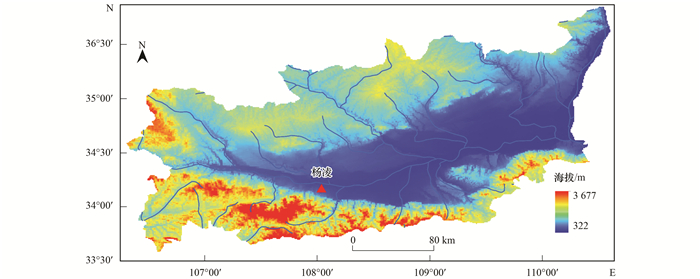
|
图 1 研究区地理位置示意 Fig. 1 Map of the geographical location of the study area |
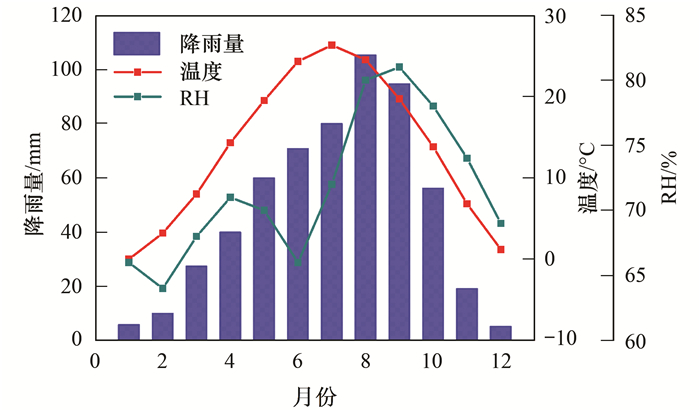
|
图 2 杨凌地区多年平均气象参数(降雨量、温度和相对湿度) Fig. 2 Multi-year average meteorological parameters (precipitation amount, temperature, and relative humidity) in the Yangling area |
本研究降水采样点位于杨凌区中国旱区节水农业研究院(34°17′47″N, 108°04′06″E), 采用自制的防蒸发降水收集装置[28]对次降水进行收集.降水样品同位素采用激光液态水同位素分析仪(liquid isotopic water analyzer-45EP, Los Gatos Research Inc., USA)进行测定, 测定结果以维也纳标准平均海水V-SMOW(vienna standard mean ocean water)标准表示:

|
(1) |
式中, Rsample和RV-SMOW分别表示降水样品和标准样品中稳定性氢同位素2H/1 H或稳定性氧同位素18O/16 O和17O/16 O的比率.δ2H、δ18O和δ17O的测量精度分别为±0.5‰、±0.1‰和±0.1‰, 根据张自超等[29]的数值修约规则, 文中δ2H、δ18O和δ17O的δ值均保留1位小数.研究所用气象数据来自中国气象数据网(http://data.cma.cn/user/toLogin.html).
1.3 d-excess与17O-excess的计算d-excess是δ2H和δ18O的二阶变量, 常用来量化降水形成过程中水汽来源和运移过程中受汽、液相稳定同位素非平衡分馏程度[9], 其表达式为:

|
(2) |
区域气象因子及最初蒸发时的海表温度变化都会引起d-excess值变化.d-excess的全球平均值通常为10[9].
17O-excess是δ17O和δ18O的二阶变量, 其值的大小可用来反映水汽源地的相对湿度[20], 表达式为:

|
(3) |
由于17O-excess比δ17O或δ18O小两个量级, 其单位通常为10-3‰, 故δ17O或δ18O的细微变化可能导致17O-excess的误差较大[30].为保证17O-excess的准确性, 在处理精度要求高的同位素比率时, 常采用修正后的δ′表示[17]:

|
(4) |
研究区次降水中δ2H、δ18O和δ17O的变化范围分别介于-99.4‰ ~22.2‰、-14.1‰ ~1.6‰和-7.4‰ ~0.8‰(图 3).同位素雨量加权后, 月均值变化范围略有减小, 分别为-96.6‰ ~0.8‰、-13.7‰ ~-1.3‰和-7.2‰ ~-0.7‰(图 3).在时间尺度上, 降水氢氧稳定同位素组成存在明显的年内变化:雨季同位素值(5~10月)较为贫化(δ2H:-48.3‰、δ18O:-7.4‰和δ17O:-3.9‰), 旱季(11月~次年4月)则相对富集(δ2H:-40.5‰、δ18O:-7.1‰和δ17O:-3.7‰), 呈现出明显的“夏低冬高”的季节性特征.此外, 该地区降水同位素还存在着一定的年际差异:相比于2016年和2017年, 2015年的降水稳定同位素年内变化并不明显(表 1和图 3), 且2015年雨季降水同位素组成比旱季更为富集, 这可能是受到厄尔尼诺事件的影响. 2014年9月起, 太平洋中、东部海温异常偏高(发生厄尔尼诺), 导致2015年夏季太平洋水汽输送份额明显增大[31], 进而影响内陆季风区降水的氢氧稳定同位素组成, 造成雨季降水同位素相对富集, 从而导致降水同位素年内变化不大[32, 33].
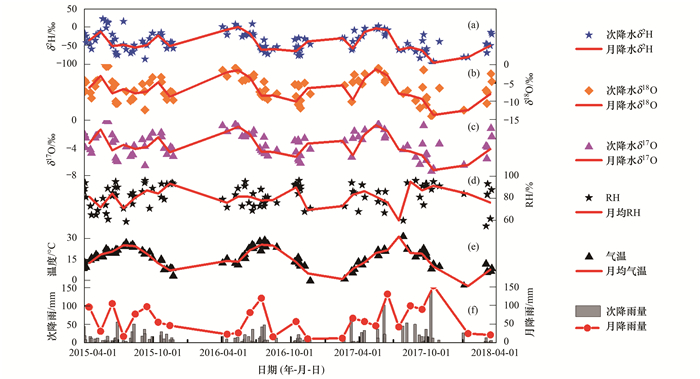
|
图 3 次和月降水同位素和气象数据的变化趋势 Fig. 3 Variation of precipitation isotopes and meteorological data in event-based and monthly weighted data |
|
|
表 1 研究区各年份降水氢氧稳定同位素(δ2H、δ18O、δ17O)及标准差(SD)/‰ Table 1 Values and standard deviations (SD) of hydrogen and oxygen stable isotopes (δ2H, δ18O, and δ17O) of precipitation in each year/‰ |
2.1.2 影响降水氢氧稳定同位素的区域气象因素
研究区降水同位素组成与当地同期气象因子(降雨量、温度和相对湿度)的回归分析显示, 其全年降水同位素(δ2H、δ18O和δ17O)与雨量显著负相关, 而与温度相关性并不显著(表 2).这与西北内陆干旱区以温度效应为主的降水同位素特征有所不同[34, 35], 与东南湿润区的降水同位素特征颇为相似[36, 37].这可能是由于杨凌地区旱季降水低频、量少, 使得旱季以温度效应为主的降水同位素特征在年尺度上被雨季显著的雨量效应所掩盖(表 2).此外, 全年和雨季的降水同位素(δ2H、δ18O和δ17O)与相对湿度均也表现出显著的负相关关系(表 2), 这可能是因为关中地区地处西北内陆, 气候干燥, 其空气相对湿度多与降水相关(r=0.68, P < 0.01), 且相对湿度的高低会一定程度上控制着雨滴的云下二次蒸发, 进而影响降水同位素的组成.综上所述, 地处湿润到干旱气候过渡带的关中平原降水同位素同时兼顾雨量和温度效应, 但受控于东南夏季风影响, 其全年降水同位素特征主要以雨量效应为主, 主要影响因素为雨量和相对湿度.
|
|
表 2 雨季、旱季和整个研究期次降水氢氧稳定同位素(δ2H、δ18O、δ17O)、d-excess和17O-excess与降水量(Q), 温度(T)和相对湿度(RH)之间的相关关系(r)1) Table 2 Correlation (r) between hydrogen and oxygen stable isotopes (δ2H, δ18O, and δ17O), d-excess, and 17O-excess vs. precipitation amount (Q), temperature (T), and relative humidity (RH) in the rainy season, dry season, and over the whole study period |
2.2 大气降水线方程和d-excess的特征
研究区次降水δ2H和δ18O建立的LMWL方程为:δ2H=7.8δ18O+9.1(R2=0.95), 见图 4(a), 其斜率低于GMWL[11](δ2H=8δ18O+10).这可能是因为关中平原地处西北内陆, 其雨滴在非饱和大气中降落时会受到云下二次蒸发的影响[38], 降水同位素易发生非平衡分馏, 从而导致重同位素富集, 降水线斜率降低.
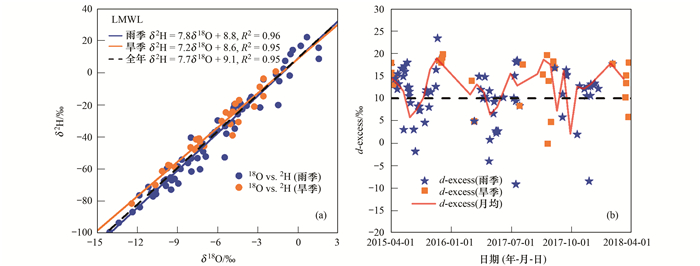
|
图 4 当地大气降水线及次和月降水d-excess的时间变化 Fig. 4 LMWLs and variations of event-based and monthly precipitation d-excess values |
区域次降水d-excess介于-9.2‰ ~23.4‰[图 4(b)], 全年d-excess与温度负相关(r=-0.55), 与相对湿度正相关(r=0.41, 表 2), 表明研究区全年降水均受到非平衡分馏的影响, 该结果与黄土高原全年都存在云下二次蒸发效应的研究结果一致[38].雨季d-excess的变化范围(-9.2‰ ~23.4‰)大于旱季[-0.1‰ ~19.8‰, 图 4(b)], 可能是由于当地雨热同期, 雨季降水多发且气温普遍偏高, 雨量差异较大的次降雨事件在雨滴降落过程中更易受到不同程度的非平衡分馏, 从而导致雨季d-excess的变异较大.另外, 由于d-excess是表征非平衡分馏的指标, 雨季d-excess与温度负相关(r=-0.60)与相对湿度正相关(r=0.40), 表明雨季降水受动力分馏和扩散分馏的共同影响; 而旱季d-excess与降雨量(r=0.43)和相对湿度(r=0.58)显著正相关(表 2), 表明旱季气温低时, 大气降水同位素的非平衡分馏变化主要以扩散分馏的方式进行.
2.3 三氧同位素大气降水线方程和17O-excess的特征研究区全年降水三氧同位素大气降水线方程为:δ′17O=0.528δ′18O+0.039[R2=0.995, 图 5(a)], 其斜率介于海水平衡分馏时的斜率(0.529)与水汽扩散至干空气中的斜率(0.518)之间[18], 表明该区域处于海洋气团向内陆干旱区迁移的路径上.此外, 雨季降水线的斜率为0.529, 其值与海水平衡分馏时的斜率相当, 表明当地雨季降水水汽多来源于海洋性气团, 且受扩散分馏影响较小, 更多地表现出平衡分馏的特征; 而旱季大气降水线的斜率为0.523, 更接近于水汽扩散到干空气中的斜率(0.518), 表明旱季环境相对湿度较低, 降水受扩散分馏的影响较大.
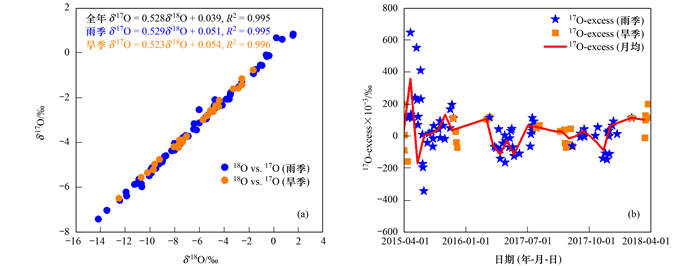
|
图 5 三氧同位素大气降水线及次和月降水17O-excess的时间变化 Fig. 5 Meteoric water lines of triple oxygen isotopes and variations of event-based and monthly precipitation 17O-excess values |
当地降水17O-excess介于-341.10×10-3‰ ~647.51×10-3‰, 平均值为31.51×10-3‰[图 5(b)], 其远大于海水的17O-excess值[(-5±1)×10-3‰][20], 表明水汽从水源地输送至杨凌的过程中受到了强烈的扩散分馏的影响.而2015年降水17O-excess的变幅(-341.10×10-3‰ ~647.51×10-3‰)远大于其余年份[2016年:-162.83×10-3‰ ~117.02×10-3‰; 2017年:-114.40×10-3‰ ~200.78×10-3‰, 图 5(b)], 这可能是由于2015年受到厄尔尼诺极端气候事件的影响, 研究区域内的极端气候事件(异常干旱/湿润)增多, 从而导致当地降水17O-excess的变幅增大. 2015年17O-excess的负值占比(21%)低于2016年(47%)和2017年(46%), 表明杨凌地区厄尔尼诺年降水受扩散分馏影响更大.Luz等[20]和Schoenemann等[39]的研究表明, 17O-excess主要受水汽源地的相对湿度控制, 而对温度、风速等气象因素并不敏感.研究区雨季17O-excess(-3.20×10-3‰)较旱季(41.16×10-3‰)低[图 5(b)和图 6(c)], 可能是由于雨季水汽源地的相对湿度较旱季高[40].此外, 旱季17O-excess与当地相对湿度显著负相关(r=-0.41, 表 2), 表明该地区旱季降水可能受到当地水汽的补给.
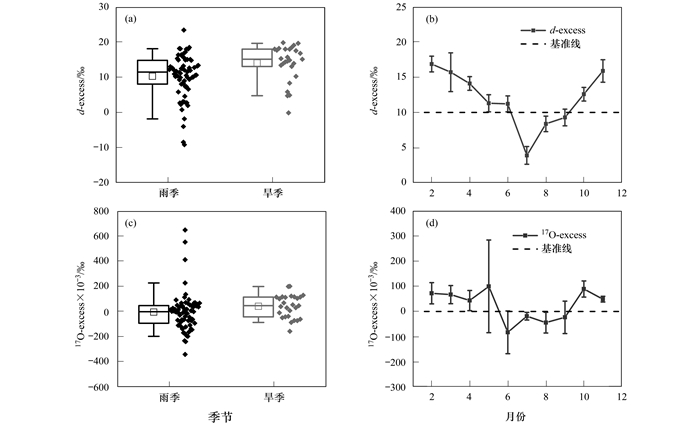
|
图 6 雨、旱两季及逐月降水d-excess和17O-excess的分布特征 Fig. 6 Distribution characteristics of d-excess and 17O-excess values in wet and dry seasons and monthly precipitation |
前人研究表明, 受季风影响较大的东南地区降水δ18O较为富集, 如杭州、鹰潭和宜昌的δ18O分别为-6.2‰、-6.5‰和-7.0‰[37, 41, 42], 而受西风影响较大的西北内陆地区, 如榆中和乌鲁木齐, 降水δ18O则较为贫化, 分别为-8.0‰和-13.6‰[43, 44].研究区地处东南沿海向西北内陆延伸的气候带上, 多年平均δ18O为-7.4‰, 该值介于东南地区降水δ18O值和西北内陆地区降水δ18O值之间, 表明当地全年降水可能受到来自东南季风的暖湿气团和西风的干冷空气共同贡献.除2015年受厄尔尼诺影响外, 研究区其余年份的降水同位素变化特征都表现出雨季贫化旱季富集的变化特征, 表明该地区雨、旱两季降水水汽来源可能不同.
由于研究区年内降水水汽来源较为复杂, 因此, 本研究尝试利用降水同位素二阶变量d-excess和17O-excess来细化研究区域内可能的水汽来源及其变化.从图 6可以看出, 研究区雨、旱两季d-excess和17O-excess特征变化基本相似.其雨、旱两季降水d-excess值分别为[(10.3±3.9)‰]和[(15.6±2.6)‰], 雨季d-excess显著低于旱季, 且接近于全球平均水平10‰[图 6(a)], 尤其是7~9月的d-excess[(7.9±3.9)‰]与低纬度地区海洋性气团的d-excess值(d-excess低于10‰)相似[36, 37], 表明研究区雨季降水主要受海洋气团主导.而旱季d-excess值均高于10‰ [图 6(a)], 可能有局地蒸发水汽参与水循环, 或者降水过程中受到强烈的云下二次蒸发影响[45], 从而导致d-excess偏大.Luz等[20]的研究发现, 海水平衡分馏时水汽的17O-excess值介于[(-5±1)×10-3‰]; 而由内陆水汽源主导的降水17O-excess为正值, 主要集中于[(37±4)×10-3‰].研究区雨季降水17O-excess为[(-3.20±11)×10-3‰, 图 6(c)], 其值与海水平衡分馏时的17O-excess值接近, 表明雨季降水水汽主要来源于海洋, 而旱季17O-excess为[(41.16±8)×10-3‰, 图 6(c)], 其值与内陆降水17O-excess相似, 表明旱季降水水汽多来源于内陆.
进一步观察d-excess和17O-excess的逐月变化, 发现两者表现出基本同步的变化趋势(图 6).研究区10月~次年4月降水d-excess和17O-excess值均在基准线上方[图 6(b)和图 6(d)], 表明降水基本来自于内陆性气团和局地蒸发, 且降水过程可能存在一定的动力学分馏, 约占年均降水量的21%; 6~8月降水17O-excess值为负值[图 6(d)], 表明降水基本来自海洋性气团, 约占年均降水量的55%.其中, 由于研究区6月气温回升且空气湿度较低(图 2), 在降水过程易发生动力学分馏, 从而导致降水d-excess略高于10‰; 5月和9月降水水汽来源较为复杂, 其17O-excess值有正有负, 可能受到海洋水汽和内陆水汽共同作用, 约占年均降水量的24%.以上信息表明, 研究区全年大约有55% ~79%的降水水汽来源于海洋, 21% ~45%的降水水汽来源于内陆和局地蒸发.
此外, 雨季降水17O-excess与δ18O显著正相关(r=0.24, 表 3), 表明降水水汽在水汽源地发生了动力分馏; 旱季降水的17O-excess与δ18O存在微弱的正相关关系(r=0.02, 表 3), 表明除水汽源地的动力分馏效应外, 还有其他因素影响降水同位素组成.雨季17O-excess与d-excess也存在显著的正相关关系(r=0.23), 说明了雨季降水水汽在降水过程中会受到动力分馏的影响.
|
|
表 3 全年、雨季和旱季17O-excess与δ18O和d-excess之间的关系 Table 3 Relationships between 17O-excess, δ18O, and d-excess during the whole year, wet season and dry season |
3 结论
(1) 研究区降水同位素组成存在明显的季节性变化, 同位素组成雨季(5~10月)贫化, 旱季(11月~次年4月)富集.受全球气候变异(如厄尔尼诺现象)的影响, 其降水同位素组成在年际尺度上也会有一定的差异.此外, 降水同位素在旱、雨季分别表现出明显的温度效应和雨量效应, 但受到东南夏季风的主导, 全年降水同位素特征主要表现为雨量效应.
(2) 研究区LMWL的斜率和截距均低于GMWL, 表明当地降水经历了一定的同位素分馏效应.其中, 雨季降水受到动力分馏和扩散分馏共同影响, 而旱季降水主要受扩散分馏的影响.
(3) 通过建立当地三氧同位素大气降水线发现, 研究区处于海洋气团向内陆干旱区迁移的路径上.其中, 雨季降水水汽多来源于海洋性气团, 受扩散分馏的影响较小; 旱季降水多来源于内陆性气团, 受扩散分馏的影响较大.
(4) 综合分析δ18O、d-excess和17O-excess发现, 研究区全年降水受到来自东南季风的暖湿气团和来自西风的干冷气团的共同贡献, 其中约有55% ~79%的降水水汽来源于海洋, 主要集中于6~8月; 21% ~45%的水汽来源于内陆和局地蒸发, 主要集中于10月~次年4月. 5月和9月的降水水汽来源较为复杂, 可能受到海洋和内陆性气团水汽的共同补给.
致谢: 感谢西北农林科技大学中国旱区节水农业研究院靳静静实验员在同位素测定工作中的大力支持与帮助.感谢西北农林科技大学节水灌溉试验站李志军老师提供的国家气象观测杨凌站的气象资料.
| [1] | Bonne J L, Masson-Delmotte V, Cattani O, et al. The isotopic composition of water vapour and precipitation in Ivittuut, southern Greenland[J]. Atmospheric Chemistry and Physics, 2014, 14(9): 4419-4439. DOI:10.5194/acp-14-4419-2014 |
| [2] | Cai Z Y, Tian L D. Processes governing water vapor isotope composition in the Indo-Pacific region:convection and water vapor transport[J]. Journal of Climate, 2016, 29(23): 8535-8546. DOI:10.1175/JCLI-D-16-0297.1 |
| [3] | Wei Z W, Kei Y, Atsushi O, et al. Understanding the variability of water isotopologues in near-surface atmospheric moisture over a humid subtropical rice paddy in Tsukuba, Japan[J]. Journal of Hydrology, 2016, 533: 91-102. DOI:10.1016/j.jhydrol.2015.11.044 |
| [4] | Zhang Z Q, Evaristo J, Li Z, et al. Tritium analysis shows apple trees may be transpiring water several decades old[J]. Hydrological Processes, 2017, 31(5): 1196-1201. DOI:10.1002/hyp.11108 |
| [5] | Joshi S K, Rai S P, Sinha R, et al. Tracing groundwater recharge sources in the northwestern Indian alluvial aquifer using water isotopes (δ18O, δ2 H and 3H)[J]. Journal of Hydrology, 2018, 559: 835-847. DOI:10.1016/j.jhydrol.2018.02.056 |
| [6] | Xiang W, Si B C, Biswas A, et al. Quantifying dual recharge mechanisms in deep unsaturated zone of Chinese Loess Plateau using stable isotopes[J]. Geoderma, 2019, 337: 773-781. DOI:10.1016/j.geoderma.2018.10.006 |
| [7] | Ma H, Yang Q, Yin L, et al. Paleoclimate interpretation in northern Ordos Basin:evidence from isotope records of groundwater[J]. Quaternary International, 2018, 467: 204-209. DOI:10.1016/j.quaint.2018.01.043 |
| [8] | O'brien G R, Kaufman D S, Sharp W D, et al. Oxygen isotope composition of annually banded modern and mid-Holocene travertine and evidence of paleomonsoon floods, Grand Canyon, Arizona, USA[J]. Quaternary Research, 2006, 65(3): 366-379. DOI:10.1016/j.yqres.2005.12.001 |
| [9] | Dansgaard W. Stable isotopes in precipitation[J]. Tellus, 1964, 16(4): 436-468. DOI:10.3402/tellusa.v16i4.8993 |
| [10] | Galewsky J, Steen-Larsen H C, Field R D, et al. Stable isotopes in atmospheric water vapor and applications to the hydrologic cycle[J]. Reviews of Geophysics, 2016, 54(4): 809-865. DOI:10.1002/2015RG000512 |
| [11] | Craig H. Isotopic variations in meteoric waters[J]. Science, 1961, 133(3465): 1702-1703. DOI:10.1126/science.133.3465.1702 |
| [12] | Coplen T. Stable isotope hydrology:deuterium and oxygen-18 in the water cycle[J]. Eos Transactions American Geophysical Union, 1982, 63(45): 861-862. DOI:10.1029/EO063i045p00861 |
| [13] | Rozanski K, Sonntag C, Münnich K O. Factors controlling stable isotope composition of European precipitation[J]. Tellus, 1982, 34(2): 142-150. DOI:10.3402/tellusa.v34i2.10796 |
| [14] | Clayton R N, Grossman L, Mayeda T K. A component of primitive nuclear composition in carbonaceous meteorites[J]. Science, 1973, 182(4111): 485-488. DOI:10.1126/science.182.4111.485 |
| [15] | Gehler A, Tütken T, Pack A. Triple oxygen isotope analysis of bioapatite as tracer for diagenetic alteration of bones and teeth[J]. Palaeogeography, Palaeoclimatology, Palaeoecology, 2011, 310(1-2): 84-91. DOI:10.1016/j.palaeo.2011.04.014 |
| [16] | Pack A, Herwartz D. The triple oxygen isotope composition of the Earth mantle and understanding variations in terrestrial rocks and minerals[J]. Earth and Planetary Science Letters, 2014, 390: 138-145. DOI:10.1016/j.epsl.2014.01.017 |
| [17] | Luz B, Barkan E. The isotopic ratios 17O/16 O and 18O/16 O in molecular oxygen and their significance in biogeochemistry[J]. Geochimica et Cosmochimica Acta, 2005, 69(5): 1099-1110. DOI:10.1016/j.gca.2004.09.001 |
| [18] | Barkan E, Luz B. Diffusivity fractionations of H216O/H217O and H216O/H218O in air and their implications for isotope hydrology[J]. Rapid Communications in Mass Spectrometry, 2007, 21(18): 2999-3005. DOI:10.1002/rcm.3180 |
| [19] | Guan H D, Zhang X P, Skrzypek G, et al. Deuterium excess variations of rainfall events in a coastal area of South Australia and its relationship with synoptic weather systems and atmospheric moisture sources[J]. Journal of Geophysical Research:Atmospheres, 2013, 118(2): 1123-1138. DOI:10.1002/jgrd.50137 |
| [20] | Luz B, Barkan E. Variations of 17O/16 O and 18O/16 O in meteoric waters[J]. Geochimica et Cosmochimica Acta, 2010, 74(22): 6276-6286. DOI:10.1016/j.gca.2010.08.016 |
| [21] | Angert A, Cappa C D, Depaolo D J. Kinetic 17O effects in the hydrologic cycle:Indirect evidence and implications[J]. Geochimica et Cosmochimica Acta, 2004, 68(17): 3487-3495. DOI:10.1016/j.gca.2004.02.010 |
| [22] |
段汉明, 陈兴旺. "一线两带"建设与关中城镇群的双向促进机制研究[J]. 人文地理, 2005, 20(6): 78-82. Duan H M, Chen X W. On the dual promotion mechanism of "One-line and two belts" construction and the city groups in centre Shannxi province[J]. Human Geography, 2005, 20(6): 78-82. DOI:10.3969/j.issn.1003-2398.2005.06.019 |
| [23] |
李俊霖, 延军平, 孙虎, 等. 关中平原东、中、西部气候干旱化程度比较分析[J]. 干旱区资源与环境, 2005, 19(1): 131-134. Li J L, Yan J P, Sun H, et al. An analysis on climatic changes in east, middle and west areas of Guanzhong plain[J]. Journal of Arid Land Resources and Environment, 2005, 19(1): 131-134. DOI:10.3969/j.issn.1003-7578.2005.01.026 |
| [24] | 李琪. 关中平原浅层地下水资源现状及管理保护对策[J]. 地下水, 2012, 34(5): 74-75. DOI:10.3969/j.issn.1004-1184.2012.05.028 |
| [25] | Juan Y, Ma Z Y, Wang Z W, et al. Oxygen and hydrogen isotope exchange of geopressured thermal water in the central Guanzhong basin[J]. Mining Science and Technology, 2009, 19(1): 115-119. |
| [26] |
王永森, 董四方, 陈益钟. 基于温度与湿度的大气降水同位素特征影响因素分析[J]. 中国农村水利水电, 2013(6): 12-15. Wang Y S, Dong S F, Chen Y Z. Research on the precipitation isotope effect factor based on temperature and humidity[J]. China Rural Water and Hydropower, 2013(6): 12-15. DOI:10.3969/j.issn.1007-2284.2013.06.004 |
| [27] |
王兴, 李王成. 南京与西安地区降水同位素的氘盈余和水汽压分析[J]. 安徽农学通报, 2018, 24(21): 126-129. Wang X, Li W C. Analysis of the influence factors of precipitation isotopes in Nanjing and Xi'an based on deuterium surplus and water vapor pressure[J]. Anhui Agricultural Science Bulletin, 2018, 24(21): 126-129. DOI:10.3969/j.issn.1007-7731.2018.21.050 |
| [28] |
陆彦玮, 司炳成, 靳静静, 等.一种新型降水同位素采样装置[P].中国专利: CN 201610224041.8, 2016-09-14. |
| [29] |
张自超, 丁悌平. 关于同位素地质测试数据的数据处理及结果表示[J]. 岩矿测试, 2000, 19(1): 77-79. Zhang Z C, Ding T P. Data processing and expression for analytical results in isotope geology[J]. Rock and Mineral Analysis, 2000, 19(1): 77-79. DOI:10.3969/j.issn.0254-5357.2000.01.015 |
| [30] | Winkler R, Landais A, Sodemann H, et al. Deglaciation records of 17O-excess in East Antarctica:reliable reconstruction of oceanic normalized relative humidity from coastal sites[J]. Climate of the Past, 2012, 8(1): 1-16. DOI:10.5194/cp-8-1-2012 |
| [31] |
温艳茹, 王建力. 重庆地区大气场降水中氢氧同位素变化特征及与大气环流的关系[J]. 环境科学, 2016, 37(7): 2462-2469. Wen Y R, Wang J L. Variations of stable isotope in precipitation and its atmospheric circulation effect in Chongqing[J]. Environmental Science, 2016, 37(7): 2462-2469. |
| [32] |
董小芳, 杨华玮, 张峦, 等. ENSO事件对上海降水中氢氧同位素变化的影响[J]. 环境科学, 2017, 38(12): 4991-5003. Dong X F, Yang H W, Zhang L, et al. Influence of ENSO events on the hydrogen (δ2H) and oxygen (δ18O) isotopic values of precipitation in Shanghai[J]. Environmental Science, 2017, 38(12): 4991-5003. |
| [33] | Tan M. Circulation effect:response of precipitation δ18O to the ENSO cycle in monsoon regions of China[J]. Climate Dynamics, 2014, 42(3-4): 1067-1077. DOI:10.1007/s00382-013-1732-x |
| [34] |
袁瑞丰, 李宗省, 蔡玉琴, 等. 干旱内陆河流域降水稳定同位素的时空特征及环境意义[J]. 环境科学, 2019, 40(5): 2122-2131. Yuan R F, Li Z X, Cai Y Q, et al. Space-time characteristics and environmental significance of stable isotopes in precipitation at an arid inland river basin[J]. Environmental Science, 2019, 40(5): 2122-2131. |
| [35] |
徐秀婷, 贾文雄, 朱国锋, 等. 乌鞘岭南、北坡降水稳定同位素特征及水汽来源对比[J]. 环境科学, 2020, 41(1): 155-165. Xu X T, Jia W X, Zhu G F, et al. Stable isotope characteristics and vapor source of precipitation in the south and north slopes of Wushaoling Mountain[J]. Environmental Science, 2020, 41(1): 155-165. |
| [36] | Liu J R, Song X F, Yuan G F, et al. Stable isotopic compositions of precipitation in China[J]. Tellus B:Chemical and Physical Meteorology, 2014, 66(1): 22567. DOI:10.3402/tellusb.v66.22567 |
| [37] | Jin Z F, Wang Y, Li F L, et al. Stable isotopes and chemical characteristics of precipitation in Hangzhou and Huzhou, East China[J]. Environmental Science and Pollution Research, 2019, 26(23): 23717-23729. DOI:10.1007/s11356-019-05712-y |
| [38] |
靳晓刚, 张明军, 王圣杰, 等. 基于氢氧稳定同位素的黄土高原云下二次蒸发效应[J]. 环境科学, 2015, 36(4): 1241-1248. Jin X G, Zhang M J, Wang S J, et al. Effect of below- cloud secondary evaporation in precipitations over the Loess Plateau based on the stable isotopes of hydrogen and oxygen[J]. Environmental Science, 2015, 36(4): 1241-1248. |
| [39] | Schoenemann S W, Steig E J. Seasonal and spatial variations of 17Oexcess and dexcess in Antarctic precipitation:insights from an intermediate complexity isotope model[J]. Journal of Geophysical Research:Atmospheres, 2016, 121(19): 11215-11247. DOI:10.1002/2016JD025117 |
| [40] |
胡月, 刘国东, 孟玉川, 等. 成都次降水稳定氢氧同位素特征及水汽来源分析[J]. 环境科学, 2019, 40(3): 1179-1187. Hu Y, Liu G D, Meng Y C, et al. Analysis of stable hydrogen and oxygen isotope characteristics and vapor sources of event-based precipitation in Chengdu[J]. Environmental Science, 2019, 40(3): 1179-1187. |
| [41] |
沈业杰, 彭新华. 鹰潭地区大气降水中氢氧稳定同位素特征研究[J]. 生态环境学报, 2014, 23(1): 101-105. Shen Y J, Peng X H. Stable isotopes of hydrogen and oxygen in the precipitation of Yingtan[J]. Ecology and Environmental Sciences, 2014, 23(1): 101-105. DOI:10.3969/j.issn.1674-5906.2014.01.015 |
| [42] |
武亚遵, 万军伟, 林云. 湖北宜昌西陵峡地区大气降雨氢氧同位素特征分析[J]. 地质科技情报, 2011, 30(3): 93-97. Wu Y Z, Wan J W, Lin Y. Characteristics of hydrogen and oxygen isotopes for precipitation in Xiling Gorge region of Yichang, Hubei province[J]. Geological Science and Technology Information, 2011, 30(3): 93-97. DOI:10.3969/j.issn.1000-7849.2011.03.013 |
| [43] | Chen F L, Zhang M J, Wang S J, et al. Environmental controls on stable isotopes of precipitation in Lanzhou, China:an enhanced network at city scale[J]. Science of the Total Environment, 2017, 609: 1013-1022. DOI:10.1016/j.scitotenv.2017.07.216 |
| [44] | Wang S J, Zhang M J, Hughes C E, et al. Factors controlling stable isotope composition of precipitation in arid conditions:an observation network in the Tianshan Mountains, central Asia[J]. Tellus B:Chemical and Physical Meteorology, 2016, 68(1): 26206. DOI:10.3402/tellusb.v68.26206 |
| [45] |
张百娟, 李宗省, 王昱, 等. 祁连山北坡中段降水稳定同位素特征及水汽来源分析[J]. 环境科学, 2019, 40(12): 5272-5285. Zhang B J, Li Z X, Wang Y, et al. Characteristics of stable isotopes and analysis of water vapor sources of precipitation at the northern slope of the Qilian Mountains[J]. Environmental Science, 2019, 40(12): 5272-5285. |
 2020, Vol. 41
2020, Vol. 41


